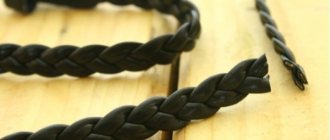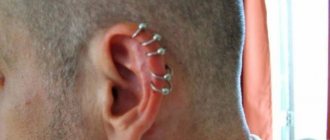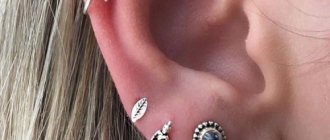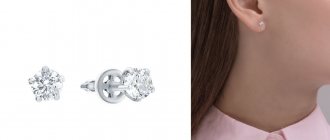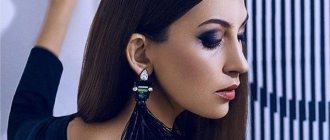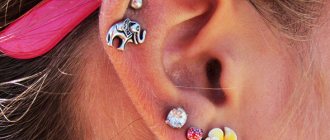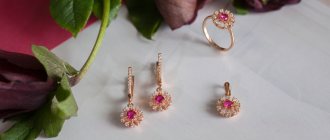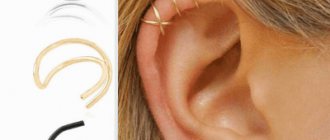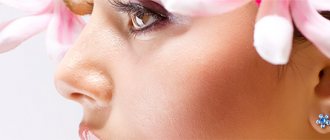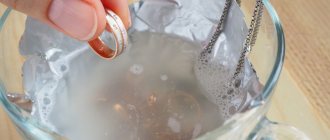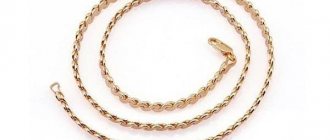To pierce your ears, you can use regular needles and do everything “the old fashioned way” by hand, or you can buy a special piercing tool, or even a whole system with replaceable cartridges and needles. The second option leaves no doubt about the correctness of the choice: with it you can maintain complete sterility during the procedure and eliminate pain. Among modern piercing devices for both professional salons and home use, the first place is taken by the Studex ear piercing gun.
This is a product of American developers, created to maximize the ease, speed and safety of the soft tissue perforation procedure. The manufacturer positions its product as an entire system, although in fact the mechanism for the device only vaguely resembles a small pistol and fits in the palm of one hand. The special design of the device guarantees sterility in any conditions, and even contact with the skin during manipulation does not affect it.
Ear piercing: pros and cons
Only a master can pierce your ears correctly. An adult can sign up for the procedure at any time in the absence of absolute contraindications. Parents and pediatricians have long been arguing about piercing the ears of young children.
Experts give a lot of arguments in favor of early piercing. They claim that children who have had their ears pierced before they are one year old will not remember the negative emotions they experienced at a more conscious age. Proponents of early piercing claim that in infancy the risk of infection of the earlobes is minimal.
Some pediatricians do not recommend performing the procedure on children under 3 years of age. At this age, the body is actively growing, the ear can take quite a long time to heal, bringing discomfort to the child. Most painkillers are contraindicated for young children.
Due to his age, the baby is quite active, so he can involuntarily catch the earring on his clothes and tear it out. Typically, a rupture of the lobe is accompanied by severe pain and bleeding. In childhood, there is a high risk of developing allergic reactions to metal (mainly nickel contained in ear jewelry).
If the clasp is not securely fastened, the earring may fall out of the ear. The decoration usually shines brightly, the child may become interested in it and swallow it. In the earlobe, the nerve endings are located close to each other. There is a high risk of hitting them when piercing.
Which earrings are best for a child?
After the puncture has completely healed, you can replace the medical studs with children's earrings.
What should you pay attention to when choosing jewelry? 1. Preferred material for children's earring: gold. Children's earrings made of high-quality gold reduce the risk of allergies in a child. Very young children (up to primary school age) are unlikely to need more than one daily pair. Earrings for children are also made of silver and jewelry alloys. The main thing is to control the origin of the jewelry (it is better to buy earrings made from jewelry alloys from European brands that guarantee the quality of the metal). And - monitor the child, removing the earrings as soon as you notice that they are causing redness or another undesirable effect.
2. Weight and shape of an earring for a girl: for comfortable wearing, earrings for children should be almost weightless so that the child does not experience discomfort and the earlobe does not pull back. The decoration itself should be as smooth as possible, without sharp or protruding parts, so as not to get hurt by them. If the decoration has an insert, the fastening must be reliable, preferably in the form of legs (prongs) so that the pebble does not wobble.
3.
Type of clasp for children's earrings: close attention should be paid to the clasp of the earring.
It must be secure so that the earrings do not come unfastened. Ease of handling is important - a girl of 5-6 years old should be able to easily take them off and put them on herself. For very little fashionistas, miniature congo earrings are perfect, the clasp of which does not have parts that can catch on clothes. This is fraught not only with the loss of jewelry, but also is traumatic for the delicate child’s earlobe. For young children, the most common choice is stud earrings , miniature loop earrings with a hook ( French lock ) or earrings with an English lock . When choosing nails for children, you need to pay attention to the degree of sharpness of the tip of the pin so that it does not scratch the skin. Stud earrings specially designed for children sometimes have a rounded plug that allows the child to sleep comfortably without removing the jewelry.
Children's earrings with stud clasps, French and English:
Particular attention should be paid to “screw studs” - which have a thread on the pin, which increases reliability and does not allow you to lose the earring.
3. Decorative elements on the earring for your child: earrings with hanging elements are not recommended for children, as they are unsafe - they can get tangled in hair or cling to clothes. However, older girls - preschool and primary school age - really like earrings with a variety of pendants, fashionable earrings, and the like. If you approach the choice of earrings responsibly, you can always find a compromise solution - one that is beautiful, reliable and safe.
In what places can you pierce, diagram of the location of puncture points
It is strictly prohibited to independently determine the location of the ear piercing. The location of the nerve endings is known only to a specialist. Most modern cosmetology clinics are equipped with special devices, with the help of which the specialist identifies dangerous areas. The zones in which bioactive points are located are characterized by high electrical conductivity.
If a highly sensitive device is not available, then the puncture location can be determined using cartography. The diagram shows biologically active points and describes in detail the relationship of one or another BAP with an internal organ or part of the body. According to cartography, there are more than 357 points on the ear. BAPs located in the helix area are responsible for the functioning of the skeleton, muscles and tendons, and the points inside the lobe are responsible for the function of the organs of vision.
Possible complications
If everything was done correctly, and the lobes were constantly monitored and cared for, then complications are very unlikely. But if something goes wrong, parents should know how to act in a given situation:
- purulent inflammation has begun - you need to show the child to a doctor and start treatment with local antibacterial drugs;
- the wounds do not heal - it is possible that the child has an immune rejection of a foreign body in the ears, you need to consult a doctor and, most likely, you will have to remove the earrings;
- signs of allergies have appeared, the temperature has risen, the earlobes have turned red, there are rashes on the neck and chest - again, you need to visit a doctor and start treatment for allergies.
What to do if your ears are pierced crookedly?
Sometimes, when the child is very small and is constantly fidgeting, not allowing the technician to do a good job, the punctures may be placed crookedly. Such a misunderstanding can also occur due to the fault of an unqualified craftsman.
For example, on one ear the earring is located higher than on the other, or the hole in the earlobe is made at an angle. What should parents do in this case?
There is no need to panic: if the earrings can be put on and do not cause discomfort, then it is possible that the specialist’s mistake will not be noticeable after healing. In the photo accompanying the article you can see how the earring should be inserted correctly.
If the earlobes were pierced incorrectly, you should contact a qualified technician who will assess the situation. If possible, you can take out the earrings, let the holes heal and perform the procedure again.
Sources
- https://kroha.info/razvitie/prokalyvanie-detskih-ushej
- https://ChildAge.ru/voprosy-otvety/kogda-luchshe-prokalyivat-ushi-devochke.html
- https://o-krohe.ru/komarovskij/kogda-prokalyvat-ushi/
- https://VseProRebenka.ru/zdorove/procedury/prokolot-ushi-rebenku.html
- https://lechim-uxo.ru/stoit-li-prokalyvat-ushi-rebenku/
- https://www.deti34.ru/ukhod/procedury/kak-uhazhivat-za-prokolotymi-ushami-u-detej.html
- https://juvelirum.ru/vidy-juvelirnyh-izdelij/sergi/seryozhki-dlya-malenkih-devochek-kak-i-kakie-vybrat/
[collapse]
Where you can't get your ears pierced
It is quite difficult to pierce your ears correctly without proper experience. There are no clear restrictions regarding the location of the ear piercing. An adult can insert an earring into almost any part of the organ. Experts do not recommend hanging jewelry on the ear - many holes can cause loss of sensitivity. If a nerve ending was damaged during the puncture process, then there is a high risk of damage to the functional activity of some internal organs and systems.
Repeated punctures slow down the healing process. Dense scars may appear on the surface of the organ of vision. In children, cartilage is actively formed at the age of 2-5 years. If a child’s ear is pierced in the “wrong” place, there is a high risk of developing pathologies in the tongue and facial muscles.
Types of ear piercings, pros and cons
There are several ways to properly pierce your ears.
The technique may vary depending on the puncture location:
- lobe piercing;
- tunnels in the ears;
- cartilage piercing;
- tragus piercing;
- shell puncture.
The puncture procedure has a number of advantages and disadvantages. The size and type of jewelry may vary depending on the location of the piercing.
Classic lobe piercing
An earlobe piercing can be considered a classic piercing option. Before marking the piercing site, the master visually divides the lobe into 9 squares.
The specialist draws a dot exactly in the center with a black marker. The area is pre-treated with alcohol. The puncture can be horizontal or vertical.
Tunnels
Tunnels in the ears are also a kind of piercing. Typically, such jewelry is worn by young people who are committed to one or another informal subculture. According to reviews, the puncture procedure is quite painful. It has a number of contraindications.
It is strictly forbidden to insert tunnels into the ears if a person has:
- at the time of puncture the temperature is increased;
- mental, neurological or vegetative disorders have been diagnosed due to alcohol abuse;
- blood diseases associated with poor blood clotting, diabetes mellitus, and epileptic seizures were previously identified;
- at the time of the puncture, any chronic diseases worsened.
The period of bearing a child and breastfeeding is considered an absolute contraindication.
Few people know that it is impossible to install a tunnel in the ears in one session. The lobe is stretched gradually.
The puncture and stretching procedure takes place in several stages:
- pierce the lobe in the center with a sterile needle;
- thread an earring (usually a stud);
- after 14 days, the earring is removed and an expander with a diameter of no more than 2 mm is inserted.
The dilator is changed every 2 weeks. The lobe should be regularly treated with various antiseptic solutions. While wearing jewelry, a person may experience pain.
Helix (cartilage piercing)
Helix is a puncture of the cartilage tissue in the upper part of the organ. The procedure is quite common. If you make several punctures, you can create a composition from earrings and jewelry. Despite the simplicity of the procedure, experts do not recommend performing it at home.
Processed with VSCOcam with j6 preset
The puncture is performed in the salon with sterile instruments. After processing the organ, markings are placed in the right place with a marker. The earlobe is pierced through, the earring is inserted with a tapper and the hole is covered with a band-aid. On the reverse side, a silicone muffler is put on the nail.
Industrial
Industrial is one of the most dangerous types of conch piercings. Several holes are made in it and connected to each other by means of a rod. Usually the earring is threaded from the bottom up. The extreme modification method is usually chosen by extravagant people. The cartilage at the top of the ear is pierced through. The tissue takes quite a long time to heal; a person experiences acute pain for 6-10 months. Throughout the entire period, lymph and ichor are released from the wound.
The process will go faster if a person has a strong immune system. Various chronic diseases slow down the healing process. The risk of complications can be reduced if you first insert not a barbell, but 2 nails into the hole. It is strictly forbidden to carry out the procedure yourself at home.
When contacting a specialized salon, first of all, the specialist selects suitable jewelry in accordance with the parameters of the auricle.
- The specialist explains to the client the nuances of further cartilage care.
- Before performing a puncture, all instruments and materials are thoroughly sterilized.
- The client is asked to fill out a form and sign consent to the procedure.
- The puncture sites are treated with an antiseptic solution, markings are applied to the skin and the cartilage is pierced through with a needle.
- After the rod has been inserted into the sink, the wounds are treated with a disinfectant solution.
You can cover the hole with adhesive tape.
Tragus (tragus piercing)
Tragus can be considered one of the varieties of extreme piercing. A hole is made in the ear tragus. A stud or earring is inserted into it. Standard jewelry is not suitable for wearing. Experts recommend choosing earrings with a thin, long stem. Studs should be made of hypoallergenic metal (for example, silver, gold).
A puncture is made in the concha cartilage, which is located near the auditory canal, next to the orbital facial joints. The markings are placed in the center, perhaps shifted 1-2 mm upward. The puncture is carried out with a sterile needle.
Snug (conch piercing)
Snug is a rather painful procedure, so piercing is performed under local anesthesia. A hole is made on both sides of the antihelix (left and right).
Suitable decorations must be selected in advance. Snug, like any piercing, is carried out with a sterile needle or a special device. Before piercing, the master explains the essence of the procedure and the nuances of further care for the damaged part of the organ.
Myth 2. It is better to insert gold earrings into a fresh piercing.
In fact, it is better to opt for hypoallergenic metals, such as nickel or silver earrings. Gold from common samples (585th sample) is 60% precious metal and 40% other “additives” (nickel, copper, silver, palladium).
Nickel is dangerous because it provokes various forms of contact dermatitis. White gold contains the most nickel; yellow gold usually contains copper.
With silver, things are also not very simple. A good option for a fresh piercing would be high-quality 925 silver, if it did not oxidize. Still, such a chemical reaction does not promote healing at all.
For the initial puncture, it is best to choose materials that do not come into active contact with the skin. Hypoallergenic titanium (a durable metal used in prosthetics and dental implants) or biocompatible polymers (bioplast, bioflex) are well suited for these purposes.
System 75 for ear piercing
The process of piercing the earlobe or ear cartilage with a medical needle is considered the most traumatic. Medicine is constantly improving. Modern clinics are equipped with special devices for ear piercing, making the procedure quick and painless.
The System 75 device, in comparison with a classic pistol, has a number of advantages. It works almost silently. The piercing procedure lasts a few seconds. The innovative device was created in the United States of America. The operating principle of the device is based on the creation of pressure. The body of the device is made of lightweight material. The ear piercing procedure is painless. The tissue heals in a few weeks.
System 75 can be considered a single use tool. The needles are supplied hermetically sealed. The cartridge is removed after the procedure. Contact of the technician with the sterile parts of the device is completely excluded. The risk of inflammatory processes caused by the penetration of pathogenic microorganisms into the wound is minimal.
Ear piercing earrings
You can get your ears pierced correctly if you follow the instructions. Piercing is considered one of the ways to modify the body. Experts recommend that you approach the choice of jewelry responsibly - earrings must fully match the depth, height and other parameters. Popular accessory options:
| Name of jewelry | Description |
| Barbells | The shape of the earring resembles a rod, at the end of which there are metal balls on both sides. The rod can be straight or curved. Also, in some versions, the balls are replaced with various decorative details (lightning, crescent, flower, butterfly). |
| Bananas | The jewelry has a curved shape. Bananas can be considered a type of barbell, just like navellas. |
| Nostrils | The shape of the jewelry resembles fishhooks, at the end of which there is a decorative detail in the form of a precious stone, an animal figurine, or a flower. |
| Fang | A kind of earring. Using decorations, the tunnels are stretched. The fang can be of different diameters. |
| Spiral | The shape resembles springs, on the reverse side of which there is a leg and a plug. |
Earrings, in addition to size, can also vary depending on the type of piercing.
For antitragus, choose jewelry that is shaped like a barbell. They are usually small in size. With daze piercing, half rings or rings are inserted into the ear.
How to choose a second earring
Fashion designers and stylists very often use images with double or triple piercings in one ear in their works. You can experiment with them endlessly. The holes in the cartilage above the ear canal are often decorated with heart studs, creating a soft and delicate image. An elegant cuff, which was previously worn by rock musicians and informal people, is suitable as an earring for the second hole in the ear.
You can insert a ring or chain with a small stud, complemented by a diamond or other precious stone, into the holes on the lobe. Two carnations connected by a spiral will look interesting.
You can put a large earring of a dark shade into the lobe, complement it with a jacket or suspender. Jewelry of different lengths, studs and cuffs inserted into the edge of the ear look stylish in a pair. This combination fits even the office dress code.
Girls with a rebellious nature may prefer combining large rings and tiny studs. The result will be a slightly domineering and at the same time playful image. Studs of different shapes and sizes, but made of the same material (gold, silver), are in perfect harmony with both evening wear and everyday wear. The largest earring is threaded into the lobe. Smaller jewelry is attached to other places on the ear and completes the ensemble.
With two earrings, you can experiment and combine jewelry in contrasting colors. The main thing is that they match in style. This combination looks especially bright when the asymmetrical earrings with three holes in the ear differ in shades. They can be decorated with enamel or complemented with precious stones.
Steel piercing in the Sunlight catalog
The choice of a duet of jewelry depends on the girl’s preferences, on what kind of image she wants to create. The main thing is not to combine cheap jewelry with expensive earrings and not to allow the presence of an overly shocking set with a business suit. Small stud earrings and an exquisite ensemble of small rings with stones are suitable for such clothes.
Preparing for a puncture
You can get your ears pierced correctly in different places in specialized salons. It is important to properly prepare for the procedure. It is advisable to make an appointment for piercing in the first half of the day - after sleep, the body is rested, energy and vital resources are at their peak. For breakfast, experts recommend eating something high in calories. This will give you an extra boost of energy.
It's important to get enough sleep. In the morning, after waking up, a person should not feel overwhelmed. You must stop drinking alcohol 48-72 hours before the expected procedure. Ethyl alcohol present in such drinks slows down the blood clotting process.
Immediately after waking up, you need to thoroughly clean the auricle and ear canal. The easiest way to do this is with a cotton swab dipped in warm water. Any medications that negatively affect the blood clotting process should be stopped 7-10 days before the intended procedure. Most medications in this category have many side effects, one of which is bleeding.
If the puncture is done in the cold season, then you need to dress as warmly as possible. Warmth must be retained in damaged tissues. It is recommended to cover your ears with a hat.
Don't be shy to ask questions to the master. The client has the right to be present in the office during the sterilization of instruments.
How to carry out the procedure correctly
Any part of the ear should be pierced according to the instructions. The procedure is carried out wearing sterile gloves and disposable instruments. It is strictly forbidden to perform piercing at home. The technique may vary depending on the type of modification.
needle
The procedure lasts several minutes.
Stages of implementation:
- Preliminary processing. Before puncturing, the master must thoroughly disinfect the epithelium. A cotton or gauze swab is moistened in ethyl alcohol, Miramistin or Chlorhexidine. Gently wipe the ear at the site of the intended puncture. Movements should be light and slow. Antiseptic treatment helps remove dirt and bacteria.
- Preparing tools. The master opens sealed packages with disposable sterile needles directly in front of the client within a minute of the intended puncture. He must work with gloves. The needle is additionally wiped with a swab soaked in Miramistin, Chlorhexidine or ethyl alcohol.
- Puncture. The master holds the auricle with the fingers of his “non-working” (usually left) hand. With the “working” limb, the piercer performs a puncture, inserting the needle horizontally. Remove the instrument carefully, trying not to make sudden movements. The second ear is pierced according to the same scheme, and earrings are inserted into the hole. Consumables (used materials) are subject to complete recycling.
After the puncture, the master re-processes the working area. The wound is wiped with an antiseptic and covered with a plaster. The earrings are tightened with plugs on the reverse side. The carnations are removed after the wound has completely healed and rods, spirals or other decorations are inserted.
With a pistol
The procedure of piercing the ear with a gun also lasts a few seconds. The earrings that are inserted into the device are made of titanium and high-quality hypoallergenic steel. The materials are almost completely biocompatible with the human body. Thanks to the tool, you can painlessly and quickly pierce your earlobe.
The procedure takes place in several stages:
- the ear is wiped with ethyl alcohol, miramistin, furatsilin or any other antiseptic solution;
- Mark the puncture site with a marker (it is important to ensure that the points are completely symmetrical);
- the lobe is placed between the plate and the cartridge;
- pull the trigger and remove the gun from your ear.
The puncture is carried out not with a needle, but with the stem of the earring. It is strictly forbidden to touch the lobe with your hands. The master tightens the earrings by installing metal or silicone plugs on them on the reverse side.
Methods
Modern children are spared the pain of having their earlobes pierced with a thick gypsy needle, as happened with their grandmothers during their youth. Today, puncture is a very quick and almost painless procedure, in some cases bloodless.
Today there are three main ways to do ear piercing:
- you can use a silent device - the “stapler” STUDEX SYSTEM 75 (which is optimal for small children who won’t even have time to get scared);
- use the so-called pistol, which is noisier, but also quite fast and safe;
- in the old fashioned way, agree to a manual puncture using special piercing needles.
Most often, parents give preference to the first two methods; they naturally cost more, but fully meet the goal - to pierce the baby’s ears quickly, painlessly, without blood and suffering, fright and long subsequent healing.
Using a needle
The traditional method is to use a special catheter needle. Mostly, the piercing procedure is carried out in medical centers and tattoo parlors where this type of service is provided. Local anesthesia is often used.
The benefits include:
- often the procedure is performed by a qualified doctor - cosmetologist or surgeon;
- in clinics the likelihood of infection is much lower;
- painlessness due to the use of anesthetic;
- the ability to choose the size of the needle for the lobe;
- You are allowed to put on jewelry immediately.
However, there are also significant disadvantages:
- the child may be afraid of the needle;
- the anesthetic is not always safe for the child’s body;
- After the procedure, discomfort is felt for some time;
- If the specialist is not sufficiently qualified, the puncture may be uneven.
The cost of the procedure varies depending on the region within 1000 rubles. Permitted from the age of three years.
Reusable gun
Gun piercing is carried out in beauty salons and some tattoo parlors. The technology consists of a puncture with a needle-earring, which instantly passes through the earlobe and is immediately fastened. The procedure is practically painless, so salons rarely offer an anesthetic.
The service has many advantages:
- disposable needle earrings that are inserted into the gun;
- almost complete absence of pain;
- a smooth hole in the lobe, as the gun mechanism is easy to operate;
- rapidity.
However, there is also a minus that can be significant for some parents. The needle earrings, which are inserted during the procedure, must be worn without removal for 2 months until the wound heals. Only after this is it possible to change them. However, manufacturers take this drawback into account and produce earrings in various shapes and colors. Often they cannot be distinguished from jewelry made of precious metals.
The cost of the procedure is up to 1000 rubles, the service is provided to children from one year old.
System 75 tool
System 75 is a new ear piercing equipment manufactured by an American company. The device is positioned as professional. The kit includes a disposable sterile cartridge with earring needles and a reusable instrument.
This method has many advantages:
- rapidity;
- noiselessness (unlike the use of a conventional pistol, the child is not scared);
- maximum sterility of the procedure, since the earring does not come into contact with the reusable instrument;
- the needle is very thin, it does not pierce, but pushes apart the tissue of the lobe, which does not cause pain at all;
- earrings are installed in cartridges immediately, which minimizes the likelihood of any mistakes due to the fault of the master;
- the earrings are packaged separately, so you can pierce the earlobes in several stages;
- earrings are made from materials that do not cause allergies - titanium, medical steel, etc.
However, there are also disadvantages:
- The earring has a very thin needle, so at first you will only have to wear earrings with a thin bow;
- limited selection of earrings, as they are specially made for System 75;
- the price is twice as high as other lobe piercing services.
Contraindications to the procedure
Despite the desire of parents to pierce the ears of their beloved children, there are a number of conditions and diseases in which it is necessary to either forget about the event for a while or abandon it altogether.
Experts identify the following contraindications (temporary or permanent) to ear piercing:
- some ophthalmological diseases;
- eczematous rashes in the ear area, dermatitis;
- intolerance to nickel alloys;
- blood clotting disorders;
- predisposition to keloid scars;
- diabetes;
- low immunity;
- period of teething;
- reduced pain threshold;
- skin damage in the area of the future puncture;
- moles on earlobes.
It is better not to pierce the ears at all if the child, who is already at a relatively conscious age, is categorically against this procedure.
Probably the refusal is due to fear of the process itself or simply a dislike of earrings. Parents should not insist and use peers as examples. The girl has the right to decide for herself whether she needs such jewelry.
Caring for your lobes after a piercing
Sanitary care must be carried out regularly. Twice a day, the earlobe or cartilage is treated with a cotton swab soaked in a sterile antiseptic solution (Miramistin, Chlorhexidine, ethyl alcohol, Furacilin, potassium permanganate solution). It is strictly forbidden to twist the earring.
Do not touch the piercing with unwashed hands. It is better to wear long hair in a ponytail. You should try not to touch your jewelry with clothing. Any rupture will be accompanied by severe pain and bleeding. You need to sleep on clean bed linen; experts recommend changing it once every 2 days. The earrings cannot be removed until the wounds have completely healed.
How long does it take for ears to heal after a piercing?
Children's ears heal quite quickly. The process takes 4-6 weeks. Lobe piercings in adults also heal in 1-1.5 months.
It is important not only to pierce your ears correctly, but also to properly treat them after piercing
The healing process of cartilage tissue is quite long and painful. The rods can be inserted into the holes 4-8 months after the puncture.
Useful tips and tricks
- Try not to move the earrings or barbells in the puncture; such actions open the wound and complicate healing.
- Ear treatment is carried out with thoroughly washed hands.
- It is necessary to eliminate the possibility of hair getting into the ear as much as possible.
- Earrings in the lobe can sometimes be rotated and moved. After these manipulations, re-treatment of the ear is necessary.
- Prolonged inflammation in the ear that does not go away within two to three days is a reason to seek medical help from a doctor.
If your ear hurts or festeres after a piercing
- The inflamed ear must be treated with peroxide or miramistin. Lightly massage your ear.
- Ichthyol ointment or aloe juice works well against the appearance of suppuration.
- A high temperature that does not drop for more than 2 days is a reason to call a doctor. Also, fever may be the body’s reaction to the wrong metal in your earrings.
What to do if your ear hurts or festeres after a piercing
If painful sensations appear after the wound has healed, then you need to remove the earrings. Most likely, the pain arose as a result of the body’s rejection of the metal from which the jewelry was made. Ears usually hurt from jewelry. Also, discomfort may occur if aseptic and antiseptic rules are not followed.
After a puncture, pain can be caused by improper care. Microtraumas can also cause discomfort. Combing the ear in the first 48-72 hours after the piercing is strictly prohibited. Redness may indicate the development of an inflammatory process in the epithelial tissues of the organ. If pus is released from the hole, you should immediately visit a surgeon.
If the ear is festered, it is first recommended to disinfect the wound. To do this, use a cotton swab dipped in hydrogen peroxide or boric alcohol. Drug therapy for inflammation includes various agents for external use. Ointments Levomekol, Tetracycline, Solcoseryl have analgesic, antimicrobial and anti-inflammatory effects. Treatment of the epithelium with antiseptic solutions should be carried out daily, morning and evening.
Traditional medicine can be used as an auxiliary therapy. Decoctions and infusions based on medicinal herbs have proven themselves well. You can brew chamomile, calendula, thyme.
It is strictly forbidden to independently select a treatment regimen. If the ear has not healed completely, the earrings cannot be removed. Cleaning and treatment of the wound should be carried out by a specialist. If the inflammatory process is caused by the material from which the jewelry is made, then you need to choose a safer option. The specialist must explain to the client all the nuances of ear care.
Proper care of a pierced ear will ensure that the wounds heal quickly. You cannot neglect the basic rules of personal hygiene. You need to wipe the skin around the ear, ear canal and sink at least 2-3 times a day. You can't twist the nails. The resulting crusts must be removed in time.
Features of care
Immediately after the procedure, the puncture sites may fester, so there is no need to worry about this, this is a completely normal reaction, be prepared for discomfort.
After the procedure, treat the wound daily for a month with one of the following antiseptics:
- hydrogen peroxide;
- alcohol;
- antiseptic lotion.
If dirt gets into the wound, treat it additionally. Ears with fresh holes should not be wetted; wear a swimming cap during water procedures.
To ensure that the ear wound heals correctly and quickly, and the jewelry does not adhere to the skin, from the second day after the procedure, rotate the earring in your ear, then wash your hands well after that.
But even after the wounds have completely healed, be careful when changing jewelry so that the puncture sites are not damaged. Sometimes even minor injuries can cause inflammation or suppuration.
Therefore, if you are going to wear new earrings, earlobes and jewelry, wipe them with antiseptics.
Wound healing time
The healing time of an ear wound depends on the individual characteristics of the person and the correctness of the procedure. Despite the fact that modern cosmetic methods allow it to be performed as safely and painlessly as possible, there is a possibility that an infection can get there.
Most often this happens when performing the procedure at home, or if unsterile instruments were used. In such cases, infection appears at the puncture sites and keloid scars form.
To prevent this from happening, contact only good specialists in a trusted salon, avoid questionable professionals who work in home or unsanitary conditions.
The healing process can take a very long time if a person is allergic to metal jewelry. You should not wear it if you are allergic to white gold, jewelry or other nickel alloys.
But there are also those who suffer from allergies to expensive metals. In this case, after a puncture, a person may experience severe ear pain, suppuration, and this in the future can provoke the addition of a microbial infection and a purulent abscess.
